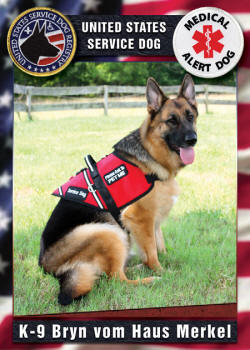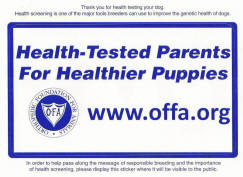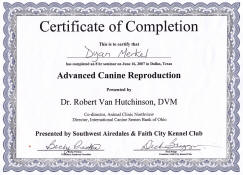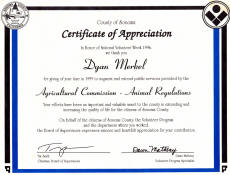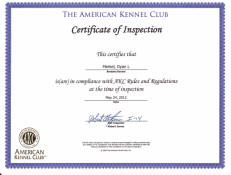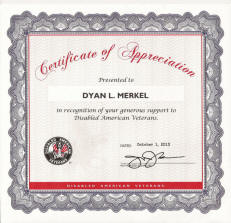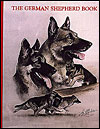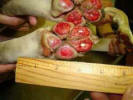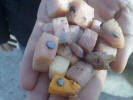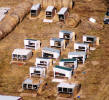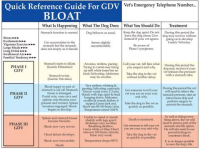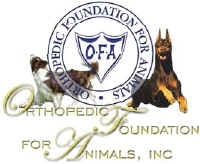|
Elements
of Temperament
(By
Joy Tiz, MS, JD 2000)
1.
What Is Temperament?
"My dog has a wonderful
temperament! . . . " Except she really hates
strangers." "I just got the perfect stud male! His
temperament is the best, it's absolutely perfect: he
has no defense drive in him at all!" "Oh, I would
never breed a dog that had prey drive, they're
vicious!"
Yes, all of these
statement were actually made by real people. All of
them German Shepherd (GSD) fanciers and breeders. We
talk all the time about the importance of temperament.
What are well all talking about? Are any of us even
talking about the same thing?
When we talk about
temperament, we are referring to a collection of
drives, thresholds, traits and instincts that are
inherited and innate. Yes, it's true. Temperament is
a function of genetics. It is inherited, not
developed. A dog's core temperament never changes.
Some behaviors can be modified through training, but
the temperament itself never changes. For example, a
high energy dervish of a dog isn't going to learn to
be a laid back, low energy dog. But, the dog can be
taught to control his energy, to an extent.
Most dog owners
absolutely refuse to believe this. If I only had a
dollar for every time someone has told me "It's all in
how they're raised!" . . . No, it's not. It's all in
how their DNA came together. A dog with foul
temperament will always be a dog with foul
temperament, no matter how wonderful the environment.
A dog with sound, stable temperament will always be a
sound, stable dog, even in a lousy environment.
Good early handling, training and
socialization will help develop desirable traits in
the dog, but those traits have to be there. Ball drive
is a good example, since it forms the foundation for
so many types of work. Some dogs aren't interested in
chasing a ball. If the dog does enjoy ball games, a
good trainer can build that up and bring it out to
it's highest possible level, but the drive itself is
innate. One cannot install a drive.
Real GSD people are
always seeking to produce sound working dogs. An
understanding of temperament is crucial to developing
a breeding program that makes sense and will preserve
working abilities rather than dump more pets into an
already overcrowded world.
1.1.
Temperament Testing
In the struggle to find
good working prospects, the question of utilizing
various temperament tests comes up. In general, the
standardized tests can be of some value, but don't put
too much faith in them. Some are truly dreadful, like
the
Volhard Puppy Temperament Test. This one is bad
news, not only because the Volhards so completely
mislabel various elements of temperament, but because
the test items themselves are too stressful for many
puppies.
For instance, on the
restraint tests, if the pup freezes in place, this is
labled as "independence". Hardly. The dog is showing
avoidance behavior. Some of their test items are
innocuous enough, such as tests of social attraction
in which you kneel and call the pup to come to you.
But, other items, designed to identify alleged future
dominant terrorists are traumatic for a weak nerved
pup. Don't be rolling over and pinning other people's
puppies, please. At best this test is misleading, at
worst it subjects puppies to needless stress for no
good reason.
The Volhards also
developed the Puppy Aptitude Testā which is something
of an improvement. The test is designed to identify
those pups who have a special talent for obedience.
They don't realize it, of course but they're actually
testing a bit of prey drive. The Volhard stuff has
really hung on. To this day, you'll hear local park
obedience instructors diagnosing all aggression as
"dominance".
A far more useful test
is the P.A.W.S. Working Dog Evaluation, by Jona Decker
which unabashedly tests prey drive. There is no
perfect test, some are more horrendous than others.
Experienced trainers of working dogs eventually come
up with their own system for evaluating pups and young
adult prospects. The best predictor of temperament is
history. What are the pup's parents like? Their
parents? Grandparents? Keeping in mind that
temperament is inherited, look to the ancestors as
your best source of information.
Also, keep in mind
that puppies are not manufactured in a factory. Just
because a dog is a GSD does not mean that by
definition, the dog will be able to work. I get calls
from dog owners all the time who can't understand why
their dogs aren't good watch dogs, protection dogs,
obedience dogs, whatever. One typical call was from a
man who had a six month old GSD puppy. He had
purchased the pup specifically to train in Personal
Protection. He needed some help with this because the
pup is scared of strangers. Whenever he has a visitor,
the pup runs and hides.
Out on a walk, if
approached by a stranger, the pup cowers and hides
behind his owner. He still honestly believes that all
he needs is the right trainer. I asked a few questions
and discovered that the pup was bred from AKC American
showlines. The AKC imposes no requirement of any type
of working title being earned prior to breeding. The
pup's parents had never had protection training. Nor
had the pup's grandparents. There was nothing in this
pup's pedigree to suggest he would have what it takes
for protection training. Yet, the unscrupulous breeder
was more than happy to take this guy's money and tell
him that his pups would make great protection dogs.
1.2.
Early Handling
What then, is the
impact of early handling, training and socializing, if
temperament is genetic? Why bother? To use a human
analogy, why can't all humans become Olympic athletes?
Because not all humans have the right genetic
equipment. But, if you are blessed with the right
stuff, the right training can develop those innate
abilities to their highest level.
It's similar with
dogs. For instance, a trainer purchased an 8 week old
GSD puppy who was completely kennel raised. She had
minimal human contact at the kennel, her only
interactions being feeding and cleaning times. Yet, at
8 weeks, this bitch pup was very interested in and
drawn toward humans. The trainer was hoping to train
this pup for Therapy work, so he chose to develop this
aspect of the dog's personality. Each time the pup
approached a stranger in a friendly manner, the
trainer rewarded her lavishly. Not surprisingly, the
pup grew into an exceptionally outgoing, social dog.
The raw genetic material was there all along, what the
trainer did was simply build on what was already
there.
Each dog has a
personality, which is different than temperament.
Personality is developed through interaction with
other living creatures, primarily humans. Pups who are
raised in enriched environments tend to have well
developed personalities, with maximum emotional range
and depth. Dogs who have been kenneled too much often
have a flatness to them, they lack the animation and
expression we like to see.
Thus, socialization
and early handling really do count, not because they
can change temperament, but because a good handler can
build on the innate traits that are already there.
And, socialization is part of personality development.
Good early handling will make a strong dog even better
and bring the weaker dog up to the extent to which the
dog is capable.
2.
Drives
An obedience instructor
who was getting interested in working dogs went to
evaluate two puppies from nice working lines. After
looking at the male and female pups, each separately,
she declared the female the better Schutzhund prospect
because she had the right drive. I went out and saw
the same two pups, and came away with the opposite
opinion. The little female was a dear pup, unusually
attentive to the human but only moderately interested
in chasing a ball. She was somewhat more interested in
grabbing a rag. The male, on the other hand, was a
maniac for the ball or anything else that moved. When
the ball rolled out of sight, he hunted for it
relentlessly. He was everywhere, into everything.
The obedience
instructor had mistaken the female pup's energy and
attentiveness for working drives. The male, however
showed plenty of prey drive as well as confidence in
new situations. He would be worth a second look as a
possible Schutzhund prospect. A local breeder
proclaimed proudly that she just had to take back one
of her male pups, because he "has too much drive!"
What did she mean by that? The pup had been
destructive in the house. Her interpretation of the
pup's shredding of the owners' belongings was that it
was a sign he had excellent drive.
A vet described her
male GSD as being "very drivey". Did that mean he
loves to chase a ball? Well, no. Not really. She meant
that he has a great deal of energy. Once again, we
have to wonder if any of us are actually talking about
the same thing. Among working dog people, you will
hear a lot of talk about drives. But, what are they?
What do they look like? Too often, the term is applied
to describe dogs who have high activity levels, but
the activity is scattered and unfocused. When we're
looking for working dogs, we're looking for high
energy, of course, but also drives that can be
channelled and focused.
A drive is an internal
mechanism that pushes the dog into taking action. All
dogs have certain basic drives. The only real
difference among dogs is a matter of degree. Think of
each drive being on a continuum. As a Real GSD
enthusiast, the drives you will be primarily concerned
with are: rank, prey, defense and pack. Keep in mind
that each drive is tied to the survival of the animal.
For example, to survive in the wild, a dog must have
the willingness and ability to capture and kill prey.
Drives are badly misunderstood, too often with tragic
results.
2.1. Rank Drive
This one should be
familiar, it's the dominance vs submissive question.
Rank drive has to do with the dog's desire to improve
his social standing. A dog who is high in rank drive
will attempt to grab the highest position in the
hierarchy. Again, you will see wide variation among
dogs. Some dogs will fight to the death to assume the
Alpha position as to the other dogs in the household,
but be completely respectful of humans and accept
human leadership without a fuss.
Some dogs will,
however attempt to dominate humans. But, remember it's
always a matter of degree. There is a wide range here,
from a mildly rank driven dog who has a cocky attitude
to a dog who won't hesitate to come up leash and nail
his handler. High rank drive dogs can actually be fun
to train because they are so self confident. But, in
it's extreme form, it's not a good trait for novice
handlers to seek out. When trained motivationally,
sane high rank drive dogs can be real stars in many
types of work. They're smart and they like showing
off. Use that.
If you're struggling
to live happily with a dominant pet dog, you'll find
lots of help in my book, I Love My Dog, But . . .
(1999 Avon Books).
Another term you'll
hear bandied about and often misused is hardness.
Breeders will advertise pups from parents with "super
hardness". The correct definition for the term
hardness is resilience. A hard dog is one who doesn't
fall apart under stress. Extreme handler hardness,
while revered by many in the working dog community
makes for a difficult dog to handle safely.
An overly soft dog is
one who will wilt at the slightest correction. Novices
are generally better off with a dog who has some
degree of hardness and won't be adversely affected by
a poorly timed or overly harsh correction. A soft dog
will show avoidance behavior in response to stress.
Or, to confuse you, there are dogs who will display
defensive aggression in response to an
over-correction.
2.2. Defense Drive
By far, this drive
causes more confusion than any other. Defense drive
refers to the dog's instinct to defend himself. It is
part of the self preservation instinct. Thus, a
complete absence of any defense drive in the GSD would
be faulty temperament. Though we would expect to see
very little defense drive in a Lab. That breed isn't
supposed to have a great deal of suspicion toward
humans. Whether this drive is problematic depends both
on the strength of the drive and the threshold at
which the drive kicks in. We will talk in depth about
thresholds in the next section.
When a dog is in
defense drive, he is displaying aggressive behaviors.
Barking, lunging, snapping, snarling and growling are
part of the constellation. The dog's hackles may be
up. Understand that the dog feels that he must fight
for his life. A dog in defense drive is under extreme
stress. He may be feeling extremely ambivalent, and
you'll see ears swiveling back and forth, the dog may
bark and back up, then move forward again. This is why
good trainers never, ever introduce elements of
defense into protection training until the dog has
sufficient emotional maturity and self confidence to
be able to manage his stress. Defensive behavior is
not fun for the dog. Unfortunately, it seems to be
really fun for far too many owners.
It's easy to
understand why so many people mistake a defensive
display with genuine protection. Remember, the dog who
is in defense feels threatened. All of the lunging,
snarling and other displays have one common goal: to
drive the threat back. That's why a defensive display
has such forwardness to it, the dog wants to push the
threat away. The best analogy I've heard so far was to
compare the dog in defense drive to a solitary wolf
being confronted by a grizzly bear (I believe this
analogy was written by Donn Yarnell). The lone wolf
knows he cannot win this fight and feels that he is
not free to flee. So, he puts on a big show, hoping to
drive the bear off.
In fact, if the dog
felt that flight was an option, he absolutely would
flee. It's very important that owners of defensive
dogs understand this. Too often, people incorrectly
assume that the dog won't bite unless he is cornered.
That's not true. All that matters is the dog's
perception of the situation. If he feels that he
cannot escape because he is on lead or even because he
could lose face, the dog could very well bite. Is
there anything positive about defense drive? Yes!!
It's essential for a good protection dog. Why? Because
defense drive is always accessible. It's not subject
to exhaustion or boredom. Defense is what puts the
seriousness into protection work. Again, it's all a
matter of degree and threshold.
Assuming the dog has
good, strong nerves and a reasonably high threshold, a
dog with strong defense drive can be a good working
dog. Keep in mind the next time someone tells you that
his growling, lunging dog is "protective", that
protection, by it's very definition requires the
presence of a legitimate, identifiable threat. If the
dog is carrying on defensively toward a non
threatening person or object, that's not protection,
that's a spook dog.
2.3. Prey Drive
This is another
misunderstood, yet essential drive. A GSD with low
prey drive is a crime against nature. Prey drive
refers to the dog's natural desire to chase, capture
and kill prey. It is completely natural and forms the
foundation for a wide variety of dog jobs, including
Schutzhund, police K9, SAR, and many others.
Tragically,
innumerable dogs are euthanized every year because no
one around understood the nature of prey drive. Humans
often insist that if the dog killed a cat or rabbit,
he will move on to bigger prey and start killing
toddlers next, which is of course, nuts. High prey
drive dogs will not attack and kill humans unless
there is some other pathological dynamic at work or
the dog lacks sound discrimination abilities. That is,
the dog must be able to tell the difference between a
gopher and a child. Most dogs can do this quite
easily, if given proper socialization in puppy hood.
A dog will not
consider as a prey object any living creature to which
he is exposed in early puppy hood, ideally around the
age of 3-5 weeks. This is why the job of the breeder
is so important! Breeders absolutely must have their
pups exposed to babies and small children. An under
socialized, high prey drive dog can easily mistake a
crying baby for wounded prey. If you have a small
animal killing dog, you may wish to read Sadie's story
in I Love My Dog, But . . .
What's so great about
prey drive, other than it's utility is that it is such
great fun for a dog. Prey and play are very closely
related. In other words, when a dog is in prey drive,
he's having a pretty good time. A high prey dog will
chase balls forever and love it. When you throw a
ball, does your dog tear after it with great
enthusiasm? Good! If it rolls out of sight, does he
continue to hunt for it, relentlessly or does he give
up and walk away? Those dogs who will continue to hunt
for their beloved tennis balls are showing hunting
instincts, which can often be channeled into work,
such as SAR.
Prey drive is also the
foundation for good protection training. Remember,
unlike defense, prey work is fun. Prey driven dogs are
not growling and snarling. They may bark, but you'll
hear a higher pitched, playful kind of bark. What
you're hearing is actually a prey flushing bark. The
dog is trying to stimulate the prey to get moving so
he can chase it. Look at the dog's body language. A
dog ready to bite the sleeve in prey mode is bouncy,
not stressed. Their ears are up, tails are up, they're
excited about the game.
In Schutzhund, the
bite sleeve ultimately becomes the prized prey object.
It's not until the dog is full of confidence and
mentally mature that the helper will begin to behave
in a threatening manner toward the dog, which is when
defense is introduced. Prey drive remains important,
however because it provides a mechanism for relieving
the stress of defensive work. If the dog is getting
too stressed, the helper can switch gears and give the
dog some fun "prey bites" by changing his body
language and movements.
Prey drive, as
wonderful and useful as it is, however will not, in
and of itself make a true protection dog. A dog
working only in prey lacks seriousness. They also
focus on equipment, rather than on the agitator. The
other problem with prey is that it is subject to
exhaustion and boredom. The dog may simply quit
working if he's being worked exclusively in prey.
Defense drive, however is always accessible. No dog is
too tired to defend himself. It's defense that adds
the serious edge to the protection work.
There are many, many
types of work in which prey is the foundation. If the
dog has good prey, you've got a built in means of
motivating and rewarding him in obedience and other
activities. Just remember that prey drive is a
comfortable place for the dog to be. And, if you
encounter a trainer who wants to start a young or
green dog in defense drive, rather than prey, run!!!
2.4. Pack Drive
We know that dogs are
highly social animals, just like their wolf ancestors.
They naturally want to be part of a group or pack. As
with all drives, dogs vary greatly as to degree of
pack drive. A dog who is independent and aloof even
with his own family would be considered to be low in
pack drive. A more social dog who can't stand to be
left out of anything the humans are doing would be
higher in pack drive.
Extremes on either end
do not make good working prospects. A dog with very
low pack drive isn't going to bond well with his human
partner and will be more difficult to motivate in
training. Some breeds are supposed to be independent
and aloof. Most GSDs bond very deeply to their
handlers.
At the other extreme
would be the dog who manifests separation anxiety.
This is a dog who, literally cannot be left alone. The
poor dog will fall apart and show vocalizations and
destructive behavior if the owner goes into another
room and closes the door. Dogs with this condition are
not good prospects for any type of work. True
separation anxiety needs to be treated medically.
To some extent, degree
of pack drive is a personal preference. Do you like a
dog who is especially attentive to you or one who is
able to amuse himself on his own? Until you get to the
outer extreme, the higher pack drive dog is easier to
train in obedience than the more aloof dog. Too much
pack drive can be a handicap in other types of work,
however. Consider the dog sent to do an area search.
This dog must be willing to leave his handler, and
stay in drive. The overly dependent dog is going to
become preoccupied with "where is my mom (or dad)?!"
and fall out of drive. This is also a function of
nerves, which we'll get to later.
A good amount of pack
drive makes for a more trainable dog because the dog's
worst nightmare is displeasing you and getting kicked
out of the pack. More independent dogs tend to also be
higher in rank drive. The dog figures we're all here
to please him, rather than the other way around.
There are actually a
number of other drives that all dogs have in common.
We've looked at those drives most crucial to success
in work. And those drives that separate the Real GSD
from those other dogs. And be aware that drives alone
do not a Real GSD make. Good drives are only useful
when combined with the right thresholds and strong
nerves.
3.
Threshholds
Thunder is my now five
year old neutered male GSD. He is byb, half West
German show lines and half who-knows-what. He is a
gorgeous black and red with (wouldn't you know it)
good hips and elbows. He is healthy, athletic and
agile. Thunder gets along exceptionally well with
other dogs, likes to clown around and greets humans
with friendly enthusiasm unless he's on his own
territory. However, Thunder's defense drive is off the
charts, and he is something of a nervebag, but luckily
for me, he's got a pretty high threshold.
Since his earliest
days in Schutzhund, Thunder has demonstrated all
defense, all the time, despite the fact that he has
excellent prey drive, it is not accessible to him
under the stress of bitework. Watching Thunder do
bitework is a lot like observing primal scream
therapy. It's stressful and exhausting for him (which
is why he is now retired from Schutzhund and doing
only scent work these days, at which he excels). He
puts on a heck of a show.
A dog with that degree
of defense drive could be a menace to all society, if
not for the threshold. By drive threshold, we mean how
quickly the dog perceives a threat and responds to it.
In Thunder's case, we are talking about defense drive
and the point at which it kicks in. On the protection
field, the sight of the helper in a sleeve is enough
to stimulate a strong reaction. That is the result of
his prior experiences, or training. It's also reality
based behavior, he has learned that the appearance of
the guy with the sleeve means he can start the action
now.
Genetically, his
overall stimulation threshold is fairly high. He
showed us this early in life. I got Thunder when he
was seven weeks old and promptly took him to his first
vet visit. After being poked and prodded by the tech,
we set him down on a metal table to wait for the vet.
Thunder reacted by stretching out and falling asleep.
Thunder has been known to conk out in other
stimulating situations. On more than one occasion, he
has taken a nap while on a long platz during one of my
group obedience classes. There are those who would
argue that going to sleep is a show of avoidance
behavior, but I don't think that fits this dog. He has
overall, a very calm temperament.
Some time ago, we were
outside of our local Pet Smart, talking to a lady who
used to breed GSDs. Thunder was on lead, doing a long
platz. A toddler appeared suddenly, came screaming up
behind Thunder and grabbed him hard on both flanks.
Thunder turned his head to see what had attacked him,
then looked up at me and went on doing his assigned
task while I reamed out the toddler's parents. The
former GSD breeder commented about what an interesting
temperament test Thunder had just taken. Thunder has
had minimal exposure to toddlers, so his reaction was
a function not of good socialization to kids, but his
threshold for stimulation. Even that obnoxious conduct
by the child was not sufficient to spark a defensive
reaction.
Callie is a three year
old, also black and red GSD owned by a client. She is
from West German showlines and came from a breeder
with a track record of producing spooks. Callie, like
Thunder has high defense drive. If a stranger gets
within ten feet of Callie, she barks, backs up, lunges
and raises her hackles. She has no reservations about
trying to bite neutral strangers. Callie reacts to non
threatening events as if her life were at stake. For
example, each and every time Callie's owner goes into
or out of the house, she closes the sliding glass door
behind her. And, every time, it makes a "thud". And
every time, Callie barks at it. If someone drops a
book on the floor, Callie goes into a barking frenzy.
Callie and Thunder
both have roughly the same degree of defense drive.
Yet, Callie cannot be approached by strangers at all,
whereas Thunder approaches strangers willingly and
allows strangers to pet him. Both Callie and Thunder
are weak nerved dogs. The difference is that they vary
greatly in stimulation thresholds (and Thunder has had
more socialization). It takes little more than a leaf
blowing by to send Callie into a defensive panic.
Conversely, it requires very specific learned cues to
throw Thunder into defense mode. Thunder can stretch
out and relax in a crowded store. Callie can't relax
on her own front lawn.
You can see that a
highly defensive dog with a low threshold for
stimulation is a very dangerous dog! This is a dog who
is very quick to perceive a threat where none exists
and react aggressively. Threshold is not another word
for nerves, rather it is a function of nerve strength.
The stronger the dog's nerves, the less likely he is
to go off in a panic over nothing and the more
stimulation is required to get the dog to react.
Some dogs react to
absolutely everything in the environment. This is not
uncommon among some of the terrier breeds. The sound
of the washing machine changing cycles or a phone
ringing sets them off into a barking, out of control
frenzy. The low threshold dog reacts to nearly
everything and often overreacts. It is very easy to
over stimulate these dogs. It's almost as if the dog
is missing some sort of filter that screens incoming
stimuli. You may have seen the calm, laid back dog
snoozing in the living room, who barely lifts his head
when a car door slams. That would be the high
threshold dog.
We had a one year old
Mastiff in a large group obedience class who had quite
a high threshold. The dog next to her was a crazy
rescued GSD with horrible nerves and a low threshold.
The poor GSD growled, lunged, barked and attempted to
bite any human or canine that got too close to his
personal space. The Mastiff pup responded by flopping
down on the grass and taking a nap.
The GSD in the group
also was prone to, when sufficiently agitated biting
his own handler when he couldn't get to the object of
his loathing. Along with his other considerable
problems, that dog was not clear headed.
3.2.
Clear In The Head
You will hear the term
clear headed bounced around a lot in working dog
circles. Clear headedness is closely related to both
thresholds and nerves. A clear headed dog is a dog who
doesn't panic easily because he is in good contact
with reality. He may have tons of drive, but has a
built in ability to cap his drive when the need
arises. If we had my Thunder out on the field being
agitated, and he was in full drive for a bite and you
were to come up behind him and pull his tail, Thunder
wouldn't bite you. That's clear in the head. He is
under maximum pressure, but still able to recognize
that you are not the threat, the guy with the sleeve
is the one to worry about.
Compare this to the
dog who goes into a frenzy when a stranger walks down
the street, or another dog goes by his window. His
owner approaches him and he bites her. What happened?
The dog lost contact with reality. He got agitated too
much for his own tolerance level. Unfortunately, this
sort of thing is very common. (See Rudy's story in I
Love My Dog, But . . .). Some trainers will tell you
this is perfectly normal for a high drive dog. No it
is not. The dog got too stressed and lost contact with
reality. That's one definition of insanity. The dog is
telling you laud and clear that his tolerance for
stress is inadequate. Biting the handler rather than
the desired object is called displacement aggression.
A well balanced dog doesn't lose his grip on reality
that easily. This is not about drives, it's about a
threshold that is dangerously low.
4.
Nerves
"Such shy animals are
in all circumstances an encumbrance to their owner,
who must be ashamed of such a dog, and a disgrace to
their race. Under no circumstances whatever must they
be used for breeding, however noble and striking they
may appear outwardly." Max von Stephanitz, The German
Shepherd Dog in Word and Picture (1925)
The essence of the
German Shepherd Dog (GSD) is character. By far, the
worst possible temperament fault in the GSD is weak
nerves. Unfortunately, this problem is rampant. Von
Stephanitz himself warned us about this long ago. In
fact, he told us that the production of weak nerved
dogs would be nothing less than the degeneration or
destruction of the breed.
Captain von Stephanitz
believed that the cause of weak nerves is kenneling,
but not in the sense of kenneling an individual dog so
as to create kennel shyness, but rather the process of
" . . . keeping animals that have been torn away
from their vocation and their natural conditions of
life have been going on for some generations . . .".
In other words, the net effect of breeding and keeping
dogs, without regard to preserving temperament and
working abilities yields weak nerves and the
inevitable destruction of the GSD. Which is, basically
where we find ourselves today.
Nobody said it would
be easy. Von Stephanitz recognized that the GSD should
be exceptionally tuned in to the environment if he is
to fulfill his obligations as guardian and protector.
The tricky part would be maintaining this heightened
alertness and sensitivity without crossing the line
into over-reactiveness. Which is why there is a system
in place to help screen dogs with faulty nerves out of
breeding programs.
As with everything
else, look at nerves on a continuum. The degree of
nerve strength will vary across individual dogs. But,
there is a minimum that must be set. The breeding
requirements under the German system are set up to
help ensure that dogs who fall below that minimum
standard are not used for breeding. Is it a perfect
system? Not at all, but it's the best one we've got.
What is a weak nerved
dog? Simply put, a weak nerved dog shows avoidance or
aggressive behaviors in response to non-threatening
people, situations or objects. This includes the shy
dogs and the fear biters. Nothing is more difficult
for a breeder or dog owner to hear than that her dog
has a nerve problem. People will go to great lengths
to bend reality around and deny the problem.
All the alarms should
go off in your head when you hear a breeder attempting
to blame the environment for a dog's behavior. For
instance, the shy pup who cringes and skitters away
from you when you crouch down to pet her. I'll bet the
breeder told you not to worry, she's just a little shy
and needs time to get to know you. And I'll bet the
breeder told you that is perfectly normal for a puppy.
Or the young adult dog who lunges and snaps at a
neutral stranger you see walking down the street and
you decide it's because the stranger was wearing a
funny hat or that your dog is just incredibly
perceptive and recognized some evil trait in the
stranger from which she was bravely protecting you.
(Actually, if your dog did this only once or twice in
a lifetime, I'd be inclined to buy it).
A dog's reaction to
neutral strangers is always significant. By neutral,
we mean the stranger walking down the street who pays
no attention to you or your dog. Does the dog ignore
the stranger? Fine. Some curiosity is well within
normal range as well. Avoidance or aggression are
signals of a serious nerve problem.
Understand that nerve
problems are not fixable. Skittering away from a scary
object or noise is not a training problem, it is a
temperament problem. With enough training, you could
teach a dog to inhibit his response to a particular
stimulus, but you will not fix the nerve problem. For
example, you could teach a weak dog not to run away
from a moving wheelchair. But suppose the wheel chair
user dropped a book on the floor. You can be certain
the dog would panic all over again.
Training can, to an
extent modify specific behaviors, but it cannot change
the dog's genetics. Weakness in temperament will
always resurface under stress. And it requires stress
tests to weed weak nerved dogs out of the gene pool.
That is why Schutzhund remains the breed suitability
test of choice. The training itself provides numerous
opportunities to evaluate the dog's overall nerve
strength. Not only during the gunfire test or
protection phase will the dog's nerves be tested. How
well does the dog focus and concentrate on the track
with a bunch of strangers around, in an unfamiliar
location? How does he handle his obedience routine in
front of a large crowd on a strange field with someone
in the parking lot honking his horn? There are plenty
of opportunities for the dog to get rattled.
Not that Schutzhund
is the perfect test, there are far too many weak dogs
being dragged through a title by talented trainers.
But, it's better than nothing! Too often, dogs are
being used for breeding without being tested for
anything. In the US, breeding has become entirely
subjective, as in "I know what I like, so I'll breed
it!" It's astonishing how many GSD breeders there are
who have no understanding of nerves. They see their
dogs, on their own turf looking confident and assume
that the dogs are just great. And puppy buyers fall
for this, too.
The typical scenario
is, puppy buyer goes to breeder's home to see a litter
of pups. The buyer is presented with six adorable
puppies, all happily playing together. They look
great. Unfortunately, this is the worst possible
scenario in which to choose a pup. All puppies look
more confident than they are on familiar territory,
surrounded by littermates and familiar humans! It's
not until you've isolated the pup from the littermates
and human friends and preferably, taken the pup to a
yet unexplored area that you can even begin to see
what you've really got.
4.1.
Sound Sensitivity
Sound sensitivity, that
is a fearful reaction to loud noises is not a synonym
for weak nerves, but is generally a symptom of a lack
of overall nerve strength. Which is why the gunfire
test remains a part of Schutzhund. The ideal response
to a sudden, loud noise is indifference. However, it
is possible to find cases of sound sensitivity that
are learned rather than genetic. For example, the
novice trainer who issues a harsh correction just as
the gun is being fired could induce a phobic response
in a sensitive dog. You'll be able to tell the
difference, however, because if it is learned
behavior, it will be specific. As in the case of the
dog who had a bad experience in training which he came
to associate with the gunshot, if the dog shows a fear
reaction only to that specific noise, in that specific
setting, the chances are that the behavior was
learned, rather than genetic. It will take a lot of
work to train this out, but it can be done, if the dog
is generally sound and stable. Dogs who are exposed to
large amounts of live gunfire, such as police dogs can
develop phobic reactions which are genuinely learned,
not inherited. Again, you will know by the narrowness
of the reaction, the avoidance behavior will occur
only in certain circumstances. The dog who can easily
ignore a car backfire or firecrackers on the Fourth of
July, but panics on the training field may have
learned a negative association.
4.2.
Life With a Weak Nerved Dog
It's no picnic. Weak
dogs are unpredictable. Combine weak nerves with a
high defense drive and low threshold and you have a
genuinely dangerous dog. Who knows what is going to
set the dog off? Owners are always stunned when their
dogs show fear aggression. They find all sorts of
excuses for it, they especially like to define it as
"protection". The owner of a seven month old pup from
who-knows-what breeding contacted me about training
for her pup. She had no prior dog experience and was
bent on breeding this male as soon as possible.
Nothing I said could talk her out of it. She believed
she had the world's best natural protection dog. Why?
Because when invited guests come to her home, the pup
plasters himself next to her, leans up against her and
growls at them.
The reality is, the
dog is a nervebag and should never be used for
breeding. It's easy to understand how this owner
mistook her dog's behavior for protection because she
didn't understand what was happening, from the dog's
point of view. The dog is scared silly of welcomed
visitors. So, he glues himself to the owner. Her close
proximity gives him just enough confidence to vocalize
his anxiety by growling. I absolutely guarantee you,
that if she wasn't there to protect the pup, he'd be
hiding under the furniture when guests arrived. Nobody
wants to hear this about their own beloved pet. But,
we all need to hear it, in hopes that these dogs will
not be used for breeding. This seven month old pup is
exactly the kind of dog we worry about most as he is
likely to mature into an unpredictable fear biter.
4.3.
We Just Felt So Sorry For the Poor Thing
If I had a dollar for
every time I heard that! Puppy buyers fall for the
shy, timid puppies. We feel sorry for them. The
breeder feeds right into our delusion that we can
offer them a wonderful home and then they will be just
fine. Baby puppies often demonstrate their weak nerves
by acting shy. They show avoidance to anything
unfamiliar. Some pups will remain avoiders, others
will mature into fear aggression. Either way, they are
risky business. Imagine a weak nerved, low threshold
dog being confronted by his first toddler tantrum?
It's a little
different for adults. Shyness in a pup is always cause
for alarm. Puppies should be into everything, curious
about everyone and pretty much a royal pain. As the
pup matures, it's perfectly normal for him to stop
jumping all over everyone. Aloofness is not the same
as shyness. It is entirely correct for a mature GSD to
be reserved with strangers, showing neither avoidance
nor aggression. A certain suspicion of new people is
also acceptable in the GSD. Far too many breeders want
their GSDs to welcome any and all onto their property
with tails wagging. They actually don't want GSDs,
they want Golden Retrievers wearing GSD uniforms.
My first GSD was a two
year old rescued former police K9 named Jet. Jet was
in a foster home when I went to meet her, accompanied
by a friend. Her foster owner brought her out and gave
me her Frisbee. Jet grabbed the Frisbee and flopped
down on the grass, making believe I wasn't there. At
no time did she take her eyes off of her foster owner.
I petted and talked to her. She ignored me. I asked if
I could have her and was thrilled when the foster
owner said yes. My friend was disappointed. She
acknowledged that Jet was exceptionally pretty, but
she didn't like her temperament at all. (My friend is
heavily into Golden Retrievers). I thought Jet's
temperament was great. She surmised quickly enough
that neither my friend nor I were threats, and
proceeded to ignore us and focus on the foster owner
to whom she had begun to bond. Jet had plenty of
faults, but her initial aloofness toward me was
totally correct for a GSD. She showed neither
aggression, nor avoidance to us, just a complete lack
of interest. (Of course, I eventually turned her into
a social butterfly and messed the whole thing up).
Jet gave us another
impromptu seminar on GSD suspicion of strangers
shortly thereafter. My then boyfriend was out of town
when I got Jet and he was eager to come over and meet
her. She woofed at the gate, but allowed me to let him
in without a complaint. She then placed her self on an
extended "watch him". When he was in the kitchen, she
laid down and kept her eyes on him. He went outside to
install some new lights, she went along, laid down and
watched every move he made. Eventually, she decided he
was ok and relaxed. They became good buddies. Again,
she showed no untoward aggression and certainly no
avoidance. She didn't instantly pounce on him to make
friends. She conducted herself like a GSD. (For more
about my adventures with Jet, visit my web site
http://www.dogbehave.com/).
Thus, we expect
puppies to let their curiosity get the better of them
and investigate all strangers with enthusiasm. With
maturity comes suspicion, and some aloofness toward
strangers is perfectly acceptable and not a symptom of
bad nerves.
4.4.
Symptoms
What does signal bad
nerves is avoidance of a non threatening human or
object or inappropriate aggression. Remember what a
dog in defense drive looks like? When you observe that
behavior in the absence of a legitimate, identifiable
threat, you're looking at a nervebag. Nervous dogs are
often very vocal, you'll hear a machine gun bark or
growling. By avoidance, we mean the dog will attempt
to get away from the imagined threat by physically
moving away or freezing in place. Rolling over is
avoidance behavior you will observe in extremely
submissive dogs. Again, remember that there is a range
here. Some nerve problems are worse than others.
One of the worst cases
I've seen so far was a 12 week old Siberian Husky pup.
I went to her home, crouched down and turned sideways
to meet her (crouching and turning sideways is, in
canine language a universal signal of friendliness).
The pup raised her hackles, growled, barked and backed
up, releasing a huge trail of urine as she escaped.
She stayed about twenty feet from me for a full twenty
five minutes before she was willing to approach me. (I
completely ignored her). Recovery time is always
important. When a pup skitters away from you or an
object, take note of the amount of time it takes for
the pup to recover and decide to approach and
investigate. Some pups will startle at an unfamiliar
object, but almost immediately regroup and check it
out. I'm a lot less worried about those pups. Twenty
five minutes is a very long recovery time.
Fortunately, the owners of the pup aren't going to
breed her!
Watch out for
growling! That is never good news. Confident dogs
don't growl at people or objects. Hackles up is
another giveaway that the dog is frightened. People
are always telling me they've got good watchdogs
because every time the dog hears a noise, the dog
growls at puts his hackles up. They're dreaming. No
matter how impressive the display, you can never rely
on a weak nerved dog for protection. The only reason
they haven't run and hid is because you're right
there. They can talk much tougher when mom or dad is
holding onto the leash.
Dogs are so much more
confident on their own turf that a lot of nerve
problems get covered up. Imagine the purchaser of an
adult dog going to see the dog. The seller may even
put on a sleeve and give the dog a few bites, to
really impress the purchaser. Be forewarned: playing
sleeve tag with his owner on his own property is not a
stress test! It tells you nothing. Get that same dog
out on a strange field, with his owner out of sight
and see what happens.
4.5.
But We Only Wanted A Nice Pet!
To paraphrase Max von
Stephanitz, GSD breeding is working dog breeding or
ceases to be GSD breeding. There are already far more
pet dogs being born than there can ever be homes for
them. There is no excuse for intentionally producing
pets. Prospective puppy purchasers must understand
that if they go to a breeder who breeds "pets", the
odds are astronomically high that they will find
themselves stuck with a weak nerved, unstable,
untrustworthy pet. Breeders who breed out of
sentiment, ego or greed do not concern themselves with
the complexities of temperament. Nerves seem to be
especially sensitive to sloppy breeding. A truly
strong dog with good nerves is getting harder and
harder to find. You're not likely to stumble upon it
by way of pet breeders.
The best pets come
from breeders who breed strictly to the SV standard.
In the best of breedings, not every pup is going to
have the same amount of drive and some will be placed
in pet homes. You're chances of getting a sound dog
are far better by seeking out a real GSD breeder. Even
if your only goal is to have a companion dog, you
still need good nerves! A nervous, high strung spook
dog makes a lousy companion. Imagine having to lock up
your dog every time company comes over? Or a dog you
can't trust with children? How about a dog you can't
even obedience train reliably because the dog is too
busy freaking out every time you leave your own
property? Do not fall for big promises from pet
breeders. If their dogs truly are stable, sound,
trainable and protective, let them prove it on the
field.
4.6.
But, My Dogs Do Work!
A few notches up from
the breed-for-pets crowd, there are breeders who
resist the standard and argue that since their dogs do
some other type of work, they are suitable for
breeding. SAR, detection, K9, agility, obedience,
assistance and other dog jobs are wonderful and we
would expect GSDs to excel in these areas. But, they
do not sufficiently stress test the dogs. Herding,
under the German system is the only exception, as
herding dogs are expected to demonstrate protection
abilities and courage. Thus, the HGH can be used in
place of a Schutzhund title. Do not confuse German
style herding with AKC herding. The other problem with
relying on some other type of work is that the plan
lacks consistently. For example, suppose the breeder
has a working SAR dog who has demonstrated courage and
confidence in training situations. That's good. But,
what evidence to we have that the dog can reproduce
those traits in his offspring? How would we test that
dog's courage, hardness and fighting instinct?
It gets really
ridiculous when breeders decide it's okay to
substitute an AKC obedience title for a Schutzhund
title, breed survey, conformation rating and endurance
test.
Also, keep in mind
that not all nerve problems manifest as plainly as the
dog who shies away from a strange object or puts his
hackles up and barks at it. Nerve weaknesses can be
very subtle, which supports the value of a balanced
breed suitability test. Consider the drug detection
dog who falls out of a search when her handler gets
too far away from her. A lack of drive? Could be. But
it could also be a nerve problem if the dog is falling
out of drive due to her anxiety when her handler isn't
close.
This is why so many
dogs are washed out of law enforcement, not only for
patrol work, but even for detection. Think a drug
detection dog doesn't need strong nerves? Oh yeah? A
weak nerved dog is not about to go away from his
handler into a strange warehouse with noisy machines
to look for drugs. This is the wrong time to find out
that the dog's nerves aren't as great as the breeder
claimed.
4.7.
Finding the Good Ones
The puppy buyer can
avoid a lot of heartache by only considering pups from
Real GSD breeders. The ones who breed to the SV
standard and understand what nerve strength looks
like. The breeders who are willing to stress test
their breeding stock and accept an objective
evaluation, even when it hurts.
A dog with good
nerve strength is a joy. He can be trusted with
children. He is never a bully, he's got nothing to
prove because he knows he can handle any situation
that should arise. And only a well bred dog with solid
nerves is the dog you can rely upon to keep you safe |

